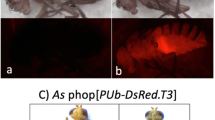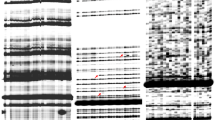Abstract
The piggyBac transposable element, originally isolated from a virus in an insect cell line, is a valuable molecular tool for transgenesis and mutagenesis of invertebrates. For heterologous transgenesis in a variety of mammals, transfer of the piggyBac transposable element from an ectopic plasmid only requires expression of piggyBac transposase. To determine if piggyBac could function in dicotyledonous plants, a two-element system was developed in tobacco (Nicotiana tabacum) to test for transposable element excision and insertion. The first transgenic line constitutively expressed piggyBac transposase, while the second transgenic line contained at least two non-autonomous piggyBac transposable elements. Progeny from crosses of the two transgenic lines was analyzed for piggyBac excision and transposition. Several progeny displayed excision events, and all the sequenced excision sites exhibited evidence of the precise excision mechanism characteristic of piggyBac transposase. Two unique transposition insertion events were identified that each included diagnostic duplication of the target site. These data indicate that piggyBac transposase is active in a dicotyledonous plant, although at a low frequency.



Similar content being viewed by others
References
Aitchitt M, Ainsworth CC, Thangavelu M (1993) A rapid and efficient method for the extraction of total DNA from mature leaves of the date palm (Phoenix dactylifera L.). Plant Mol Biol Rep 11:317–319
Balu B, Shoue DA, Fraser MJ Jr, Adams JH (2005) High-efficiency transformation of Plasmodium falciparum by the Lepidopteran transposable element piggyBac. Proc Natl Acad Sci USA 102:16391–16396
Cary LC, Goebel M, Corsaro BG, Wang HG, Rosen E, Fraser MJ (1989) Transposon mutagenesis of baculoviruses: analysis of Trichoplusia ni transposon IFP2 insertions within the FP-locus of nuclear polyhedrosis viruses. Virology 172:156–169
Deininger PL, Roy-Engel AM (2002) Mobile elements in animal and plant genomes. In: Craig NL et al (eds) Mobile DNA II. ASM Press, Washington, DC
Ding S, Wu X, Li G, Han M, Zhuang Y, Xu T (2005) Efficient transposition of the piggyBac (PB) transposon in mammalian cells and mice. Cell 122:473–483
Elick TA, Bauser CA, Fraser MJ (1996) Excision of the piggyBac transposable element in vitro is a precise event that is enhanced by the expression of its encoded transposase. Genetica 98:33–41
Feschotte C, Jiang N, Wessler SR (2002) Plant transposable elements: where genetics meets genomics. Nature Rev Genet 3:329–341
Fraser MJ, Cary L, Boonvisudhi K, Wang HG (1995) Assay for movement of Lepidopteran transposon IFP2 in insect cells using a baculovirus genome as a target DNA. Virology 211:397–407
Fraser MJ, Ciszczon T, Elick T, Bauser C (1996) Precise excision of TTAA- specific lepidopteran transposons piggyBac (IFP2) and tagalong (TFP3) from the baculovirus genome in cell lines from two species of Lepidoptera. Insect Mol Biol 5:141–151
Kim A, Pyykko I (2011) Size matters: versatile use of piggyBac transposons as a genetic manipulation tool. Mol Cell Biochem 354:301–309
Koprek T, Rangel S, McElroy D, Louwerse JD, Williams-Carrier RE, Lemaux PG (2001) Transposon-mediated single-copy gene delivery leads to increased transgene expression stability in barley. Plant Physiol 125:1354–1362
Li J, Zhang JM, Li X, Suo F, Zhang MJ, Hou W, Han J, Du LL (2011) A piggyBac transposon-based mutagenesis system for the fission yeast Schizosaccharomyces pombe. Nucleic Acids Res 39:e40
Li X, Burnight ER, Cooney AL, Malani N, Brady T, Sander JD, Staber J, Wheelan SJ, Joung JK, McCray PB Jr, Bushman FD, Sinn PL, Craig NL (2013) piggyBac transposase tools for genome engineering. Proc Natl Acad Sci USA 110:E2279–E2287
Liu YG, Chen Y (2007) High-efficiency thermal asymmetric interlaced PCR for amplification of unknown flanking sequences. Biotechniques 43:649–656
Lobo NF, Fraser TS, Adams JA, Fraser MJ Jr (2006) Interplasmid transposition demonstrates piggyBac mobility in vertebrate species. Genetica 128:347–357
Maliga P, Klessig DF, Cashmore AR, Gruissem W, Varner JE (1995) Methods in plant molecular biology. Cold Spring Harbor Laboratory Press, Cold Spring Harbor, p 76
Miller SA, Dykes DD, Polesky HF (1988) A simple salting out procedure for extracting DNA from human nucleated cells. Nucleic Acids Res 16:1215
Nishizawa-Yokoi A, Endo M, Osakabe K, Saika H, Toki S (2014) Precise marker excision system using an animal-derived piggyBac transposon in plants. Plant J. 77:454–463
Owens JB, Urschitz J, Stoytchev I, Dang NC, Stoytcheva Z, Belcaid M, Maragathavally KJ, Coates CJ, Segal DJ, Moisyadi S (2012) Chimeric piggyBac transposases for genomic targeting in human cells. Nucleic Acids Res 40:6978–6991
Sarkar A, Sim C, Hong YS, Hogan JR, Fraser MJ, Robertson HM, Collins FH (2003) Molecular evolutionary analysis of the widespread piggyBac transposon family and related “domesticated” sequences. Mol Genet Genomics 270:173–180
Sierro N, Battey JN, Ouadi S, Bovet L, Goepfert S, Bakaher N, Peitsch MC, Ivanov NV (2013) Reference genomes and transcriptomes of Nicotiana sylvestris and Nicotiana tomentosiformis. Genome Biol 14:R60
Southern EM (1975) Detection of specific sequences among DNA fragments separated by gel electrophoresis. J Mol Biol 98:503–517
Tamura T, Thibert C, Royer C, Kanda T, Abraham E, Kamba M, Komoto N, Thomas JL, Mauchamp B, Chavancy G, Shirk P, Fraser M, Prudhomme JC, Couble P (2000) Germline transformation of the silkworm Bombyx mori L. using a piggyBac transposon-derived vector. Nat Biotech 18:81–84
Thibault ST, Singer MA, Miyazaki WY, Milash B, Dompe NA, Singh CM, Buchholz R, Demsky M, Fawcett R, Francis-Lang HL, Ryner L, Cheung LM, Chong A, Erickson C, Fisher WW, Greer K, Hartouni SR, Howie E, Jakkula L, Joo D, Killpack K, Laufer A, Mazzotta J, Smith RD, Stevens LM, Stuber C, Tan LR, Ventura R, Woo A, Zakrajsek I, Zhao L, Chen F, Swimmer C, Kopczynski C, Duyk G, Winberg ML, Margolis J (2004) A complementary transposon tool kit for Drosophila melanogaster using P and piggyBac. Nat Genet 36:283–287
Wang HH, Fraser MJ (1993) TTAA serves as the target site for TFP3 lepidopteran transposon insertions in both nuclear polyhedrosis virus and Trichoplusia ni genomes. Insect Mol Biol 1:1–7
Wilson MH, Coates CJ, George AL Jr (2007) PiggyBac transposon-mediated gene transfer in human cells. Mol Ther 15:139–145
Wu SC, Meir YJ, Coates CJ, Handler AM, Pelczar P, Moisyadi S, Kamski JM (2006) piggyBac is a flexible and highly active transposon as compared to sleeping beauty, Tol2, and Mos1 in mammalian cells. Proc Natl Acad Sci USA 103:15008–15013
Yusa K, Zhou L, Li MA, Bradley A, Craig NL (2011) A hyperactive piggyBac transposase for mammalian applications. Proc Natl Acad Sci USA 108:1531–1536
Zhu QH, Upadhyaya N, Helliwell (2012) Transposon mutagenesis for functional genomics. In: Shu QY, Forster BP, Nakagawa H (eds) Plant mutation breeding and biotechnology. CABI, Wallingford, pp 507–522
Acknowledgments
We thank Malcom Fraser for supplying the piggyBac transposable element and transposase. We are grateful to Keith Johnson and Stephen Hughes for comments on a draft manuscript. David Lee, Mark Doehring, and Kay Shopinski provided excellent technical assistance. This study was supported by CRIS Project 3620-42000-040-00D base funds from the USDA. The mention of firm names or trade products in this manuscript does not imply that they are endorsed or recommended by the USDA over other firms or similar products not mentioned. USDA is an equal opportunity provider and employer.
Author information
Authors and Affiliations
Corresponding author
Additional information
Communicated by S. Hohmann.
Electronic supplementary material
Below is the link to the electronic supplementary material.
Rights and permissions
About this article
Cite this article
Johnson, E.T., Dowd, P.F. A non-autonomous insect piggyBac transposable element is mobile in tobacco. Mol Genet Genomics 289, 895–902 (2014). https://doi.org/10.1007/s00438-014-0860-2
Received:
Accepted:
Published:
Issue Date:
DOI: https://doi.org/10.1007/s00438-014-0860-2




